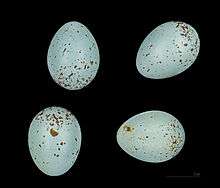Western black-eared wheatear
The western black-eared wheatear (Oenanthe hispanica) is a wheatear, a small migratory passerine bird that was formerly classed as a member of the thrush family Turdidae, but is now considered to be an Old World flycatcher (family Muscicapidae). It was formerly (and still is by some authorities) considered conspecific with the eastern black-eared wheatear.
| Western black-eared wheatear | |
|---|---|
 | |
| male | |
| Scientific classification | |
| Kingdom: | Animalia |
| Phylum: | Chordata |
| Class: | Aves |
| Order: | Passeriformes |
| Family: | Muscicapidae |
| Genus: | Oenanthe |
| Species: | O. hispanica |
| Binomial name | |
| Oenanthe hispanica | |
| Synonyms | |
|
Motacilla hispanica Linnaeus, 1758 | |

The breeding male has the forehead and crown white or nearly white, the mantle buff, and the wings blacker than those of the northern wheatear. The underparts are white tinged with buff. The back, upper tail coverts and most of the tail are white. A black mask extends from the ear coverts to the bill. The throat can be either black or white.
In autumn and winter the head and mantle are distinctly buff, as are the underparts (including the throat in non-black-throated individuals), but the buff varies in intensity. Except for the central pair, the tail feathers are much whiter than in the northern wheatear, the white on the inner web often extending to the tip.
The female is a browner bird, but has the characteristic white lower back, and her seasonal changes are less marked.
The male western black-eared wheatear can be distinguished from the male eastern black-eared wheatear by its more buff-tinged upperparts, giving it a less distinctly black-and-white appearance than the latter species, as well as having the black of the mask stopping at the base of the bill rather than extending slightly above. Black-throated individuals of this species have less black on the throat and face than on the eastern birds, and the black generally terminates less abruptly. Females of this species differ from their eastern counterparts in being warmer brown overall.
Etymology
The genus name Oenanthe is derived from the Ancient Greek oenos (οίνος) "wine" and anthos (ανθός) "flower". It refers to the northern wheatear's return to Greece in the spring just as the grapevines blossom. The specific hispanica is Latin for "Spanish".[2] "Wheatear" is not derived from "wheat" or any sense of "ear", but is a 16th-century linguistic corruption of "white" and "arse", referring to the prominent white rump found in most species.[3]
References
- BirdLife International (2012). "Oenanthe hispanica". IUCN Red List of Threatened Species. 2012. Retrieved 26 November 2013.CS1 maint: ref=harv (link)
- Jobling, James A. (2010). The Helm Dictionary of Scientific Bird Names. London, United Kingdom: Christopher Helm. pp. 193, 280. ISBN 978-1-4081-2501-4.
- "Wheatear". Oxford English Dictionary (3rd ed.). Oxford University Press. September 2005. (Subscription or UK public library membership required.)
Further reading
birding.nl/content/journal/pdf/1994-5.pdf Identification of Pied Wheatear and Eastern Black-eared Wheatear] Dutch Birding 16(5): 186–194
- Ullman, Magnus (2003) Separation of Western and Eastern Black-eared Wheatear Dutch Birding 25: 77–97
External links
- Black-eared Wheatear videos, photos & sounds on the Internet Bird Collection
- Ageing and sexing (PDF; 3.8 MB) by Javier Blasco-Zumeta & Gerd-Michael Heinze
